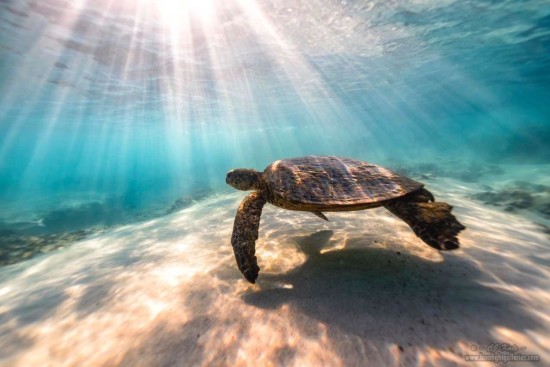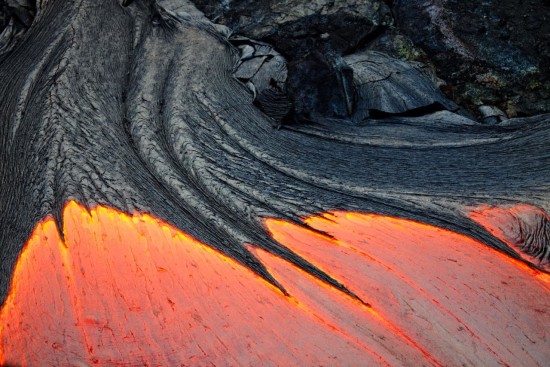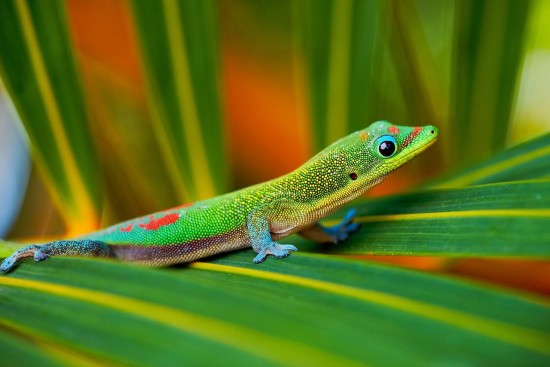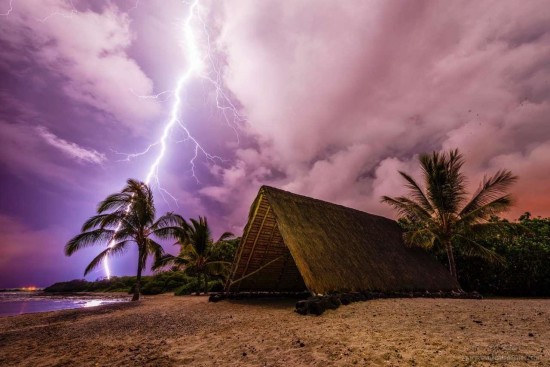CJ Kale is a highly talented and professional nature photographer from Hawaii’s Big Island. In 2011, CJ (deemed a “daredevil photographer”) fell 20 feet into a lava tube while shooting the Kilauea Volcano and shattered his ankle. Even this was not enough to deter him; only a few months later, he was back in the surf and lava fields doing what he does best. CJ’s nature photography portfolio from Big Island of Hawaii includes a diverse set of images – underwater images; photos of rain forests, mountains, ocean, and wildlife; and of course, flowing lava. CJ was kind enough to share with InFocus Newsletter readers nature photography tips for photographing diverse terrain found on the Big Island of Hawaii.
Big Island’s Diverse Terrain
The Big Island of Hawaii is an extremely diverse terrain. Within an few hours you can photograph seascapes, mountainous terrain, rolling hills and pastures, rain forests, waterfalls and, to top it all off, a volcano. The Big Island has 4 of the 5 major climate zones and 8 of the 13 sub-climates. This makes for very diverse weather that can change in moments. Or as we say here in the islands, you just drive to the water you want.
Preparing for Nature Photography on Big Island
When photographing a diverse landscape with changing weather conditions, it’s important to be prepared. Sometimes this means bringing more gear then you’ll need for any one shot. I always have in my car a rain jacket and umbrella, a second pair of shoes (either water shoes or hiking shoes/socks), and a cold weather jacket. Dress for the diversity. I normally dress for where I’m going but I also bring clothes for where I may wind up. So, if I am heading into the rain forest, I wear pants, hiking shoes, and a shirt. But under my pants or in the car, I keep swimwear in case I wind up at the ocean.
You must be prepared for your plans to change and other opportunities to arise. The photographic gear you bring is as diverse as the landscape and the shots that you can imagine. It’s not uncommon for me to shoot a sunrise on a tripod from the beach then put my camera in a water housing and shoot surf or marine life I happen to come across such as a turtle or dolphins. Later, I may leave the beach and photograph birds up in the pastures or rain forest, find a few waterfalls, shoot a mountain sunset, then wind up finishing up the day shooting stars over the volcano.
Like I said, the photo gear you bring may be as diverse as the landscape itself. When traveling, all of this gear may not be practical. I suggest that you bring gear for the shots that are most important to you but, if you want to cover the range quality, zoom lenses are your friend. I recommend a wide-angle zoom, a telephoto zoom and, for the middle range, a few fast prime lenses. My normal daily pack includes my camera, lenses (14-24mm, 24mm 1.4, 50mm 1.4, 85mm 1.4, 50-500mm tele zoom), tripod, strobe, cable release, filters, extension tubes, extra memory cards, batteries and, if the surf is good, a water housing. The faster prime lenses are great for sharpness and low light situations and they also work well with the extension tubes if you run into something in the macro realm you want to shoot.
Another tip is to bring two photo bags – one for the gear you are shooting at the moment and the other to pack away the gear you may need for a different location/situation. Just remember… if you are leaving gear in your car, be sure it’s insured and switch up gear at a location where people can see what you are leaving behind. The safest bet is to have all the gear backed in their applicable bags; you can grab a bag and go with no one realizing there’s still expensive equipment left in your car.
Developing Photography Skills
As for skills needed to shoot diverse landscape… they’re pretty much the same as you need in any other location with the exception that you must be able to quickly adapt to changing settings and weather conditions. Since I shoot for weather and color, I check the weather and adjust my shooting location accordingly. I spend much of my time looking for changes and having other compositions in mind. If another opportunity presents itself, I can adapt quickly to the new shot. While I almost always shoot on a tripod, I never hesitate to move my whole setup if a change occurs.
The most important thing in a diverse landscape is local knowledge. To increase your odds of getting a great shot in a diverse landscape, do a lot of research and educate yourself before arriving. Learn the landscape, the local wildlife and, most importantly, the weather conditions of each area you plan to shoot during the time you’ll be there. Even better, employ a local guide to help you. I recommend one that specializes in photography because, while any guide can take you to the hot spots, a photographic guide will get you there at the best possible times.
Finally, the only other skills that are needed are tailored to each individual shot. It should go without saying if you can’t swim, don’t try to shoot surf from in the water, or if you are not skilled at climbing mountains, photos from the side of one may be out of the question. If you have a certain shot you are looking to capture in a landscape, practice and develop the skills needed to obtain that shot before arriving.
Big Island Nature Photos Timing
What is the best time for Big Island Photography is a great question. The best thing about diverse terrain is that you can pretty much shoot anytime… you just need to change the where. If it’s raining, photos in the rain forest with water dripping off of ferns and flowers, or waterfalls and streams can be amazing. If is completely clear, underwater images, birds in the rainforest or pastures, and also stars at night (depending on moon phase) can be fantastic. The leading and trailing edges of storms are almost always great to give the sky color and interest during sunsets and sunrises. Then of course, is my personal favorite – extreme weather. Capturing major storms and lightning over historical sites is always good time. You’ll find that this is the biggest advantage of a diverse landscape – anywhere you are in the world, you’ll have the option to shoot and capture something that works with the changing weather.
Popular Big Island Photography Locations
Here are some of the most popular Big Island Photography Locations to capture stunning nature photos:
CJ and his best friend, Nick Selway own Lava Light Galleries together in Kailua Kona Hawaii. If you are on Big Island, feel free to stop by and say hi. They love meeting customers face-to-face and will gladly share their passion for photography and Hawaii.
Visual Wilderness https://ift.tt/32ZMm7P
Sourced by Time Trap Photography sharing the best photography tips, news and tricks throughout the industry. Time Trap Photography is dedicated to freezing those special moments in life that can be revisited and admired for generations to come. - Shannon Bourque
Please visit our main site for booking availability and rates.

Receive valuable industry knowledge delivered free to your email each day.



















No comments:
Post a Comment
Thank you so much for your comment. A moderator will review and approve all relevant posts. We appreciate your support and encourage you to stay with us by subscribing to our email updates. Where you can easily pick and choose what photography subjects interests you. Subscription link: http://bit.ly/photo-sub